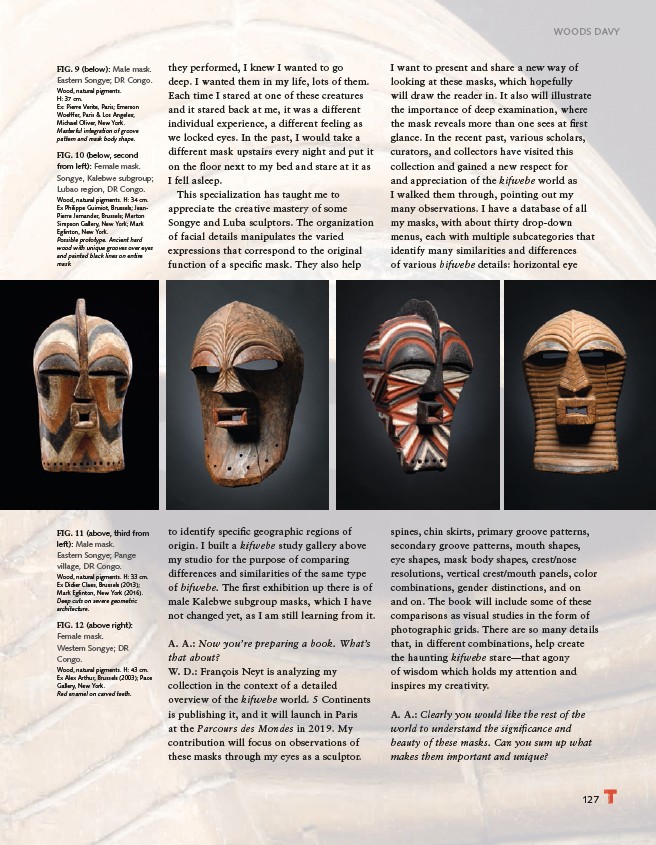
WOODS DAVY
127
FIG. 9 (below): Male mask.
Eastern Songye; DR Congo.
Wood, natural pigments.
H: 37 cm.
Ex: Pierre Verite, Paris; Emerson
Woelffer, Paris & Los Angeles;
Michael Oliver, New York.
Masterful integration of groove
pattern and mask body shape.
FIG. 10 (below, second
from left): Female mask.
Songye, Kalebwe subgroup;
Lubao region, DR Congo.
Wood, natural pigments. H: 34 cm.
Ex Philippe Guimiot, Brussels; Jean-
Pierre Jernander, Brussels; Merton
Simpson Gallery, New York; Mark
Eglinton, New York.
Possible prototype. Ancient hard
wood with unique grooves over eyes
and painted black lines on entire
mask.
FIG. 11 (above, third from
left): Male mask.
Eastern Songye; Pange
village, DR Congo.
Wood, natural pigments. H: 33 cm.
Ex Didier Claes, Brussels (2013);
Mark Eglinton, New York (2016).
Deep cuts on severe geometric
architecture.
FIG. 12 (above right):
Female mask.
Western Songye; DR
Congo.
Wood, natural pigments. H: 43 cm.
Ex Alex Arthur, Brussels (2003); Pace
Gallery, New York.
Red enamel on carved teeth.
to identify specifi c geographic regions of
origin. I built a kifwebe study gallery above
my studio for the purpose of comparing
differences and similarities of the same type
of bifwebe. The fi rst exhibition up there is of
male Kalebwe subgroup masks, which I have
not changed yet, as I am still learning from it.
A. A.: Now you’re preparing a book. What’s
that about?
W. D.: François Neyt is analyzing my
collection in the context of a detailed
overview of the kifwebe world. 5 Continents
is publishing it, and it will launch in Paris
at the Parcours des Mondes in 2019. My
contribution will focus on observations of
these masks through my eyes as a sculptor.
spines, chin skirts, primary groove patterns,
secondary groove patterns, mouth shapes,
eye shapes, mask body shapes, crest/nose
resolutions, vertical crest/mouth panels, color
combinations, gender distinctions, and on
and on. The book will include some of these
comparisons as visual studies in the form of
photographic grids. There are so many details
that, in different combinations, help create
the haunting kifwebe stare—that agony
of wisdom which holds my attention and
inspires my creativity.
A. A.: Clearly you would like the rest of the
world to understand the signifi cance and
beauty of these masks. Can you sum up what
makes them important and unique?
they performed, I knew I wanted to go
deep. I wanted them in my life, lots of them.
Each time I stared at one of these creatures
and it stared back at me, it was a different
individual experience, a different feeling as
we locked eyes. In the past, I would take a
different mask upstairs every night and put it
on the fl oor next to my bed and stare at it as
I fell asleep.
This specialization has taught me to
appreciate the creative mastery of some
Songye and Luba sculptors. The organization
of facial details manipulates the varied
expressions that correspond to the original
function of a specifi c mask. They also help
I want to present and share a new way of
looking at these masks, which hopefully
will draw the reader in. It also will illustrate
the importance of deep examination, where
the mask reveals more than one sees at fi rst
glance. In the recent past, various scholars,
curators, and collectors have visited this
collection and gained a new respect for
and appreciation of the kifwebe world as
I walked them through, pointing out my
many observations. I have a database of all
my masks, with about thirty drop-down
menus, each with multiple subcategories that
identify many similarities and differences
of various bifwebe details: horizontal eye